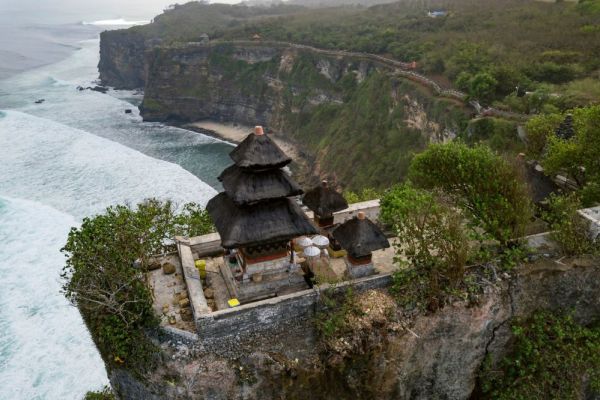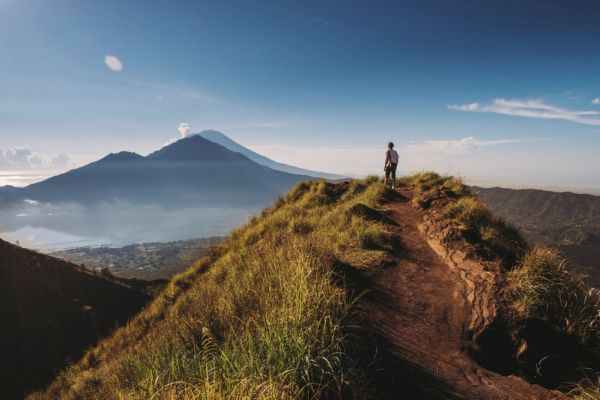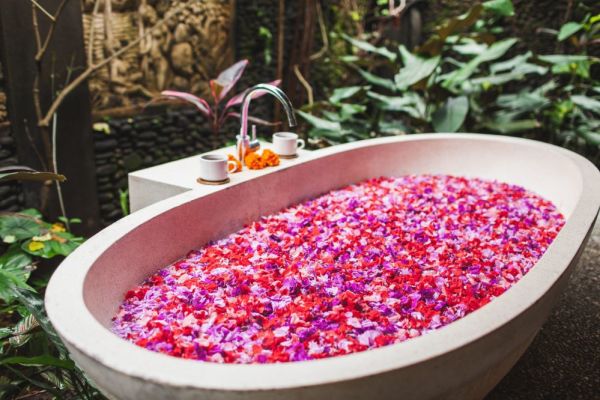BaliTravel Guide
Bali is synonymous with blissful escape, whether it’s the relaxing beach vibe that lures you, the nightlife, the zen-like mountainside retreats, the welcoming and friendly people – or all of the above. Kuta, Nusa Dua, Legian, Seminyak… Bali has many different neighbourhoods, each with its own personality and loyal fans. With an ever-changing kaleidoscope of bars, hotels and things to do, one visit to Bali is just never enough. If you’re planning a visit, explore our Bali travel guide and find out how to make the most of your time in one of Australia’s best-loved travel destinations. We’ve collected the best tips from our travel experts, and have all sorts of suggestions for things to do, the best time to travel, where to stay in Bali, how to get around, and more. We even have a handy guide to Bali’s Ngurah Rai International Airport.
Explore Bali
Where to stay in Bali?
Some Bali locations are famous for their beaches, others for their luxury, and further still for their arts. When it comes to deciding where to stay in Bali, the truth is you’re spoiled for choice. If it’s a lively atmosphere that appeals, Kuta and Legian offer a vibrant ambiance with easy access to dining, markets, cultural attractions, and shopping. Meanwhile, the high-end enclaves of Seminyak and Nusa Dua are known for their luxury feel, and Ubud boasts a selection of some of the finest relaxation retreats on the island.Choosing where to stay ultimately comes down to what you hope to explore and how you prefer to spend your time.
Home to some of Bali's most luxurious resorts, Seminyak offers a quieter alternative to its lively neighbours, Legian and Kuta. Many resorts overlook picturesque Seminyak Beach, offering beachfront access, spectacular sunsets, and proximity to the shopping boutiques and high-end restaurants within the immediate vicinity. Seminyak is also within walking distance of Kuta, making it a convenient location for exploring a range of Bali attractions.
Known for its vibrant nightlife, Legian is the second-most popular place to stay within the Bali region. Resorts and accommodation line the beachfront, providing ready access to water sports, shopping, restaurants, and more. If it's the buzz of activity you seek, with excitement at any hour of the day, then Legian is perhaps the destination best suited to meeting your needs.
Of all the places to stay in Bali, Nusa Dua is arguably the most exclusive precinct available. The region was specifically designed as an “all-inclusive” tourism enclave, and it features luxurious and world-renowned resorts with immediate beachfront access. There's also a golf course and a shopping centre. Kuta and Denpasar International Airport are both a quick taxi ride away, making this a convenient location of world-class standard.
Canggu is widely regarded as one of the best areas to stay in Bali due to its emerging popularity as a beachside destination and truly laidback feel. Featuring new beachside resorts, the region is also home to diverse beaches that have sands ranging from black in some areas through to the creamy shorelines so familiar in the island's south.
If you're looking for accommodation positioned in the thick of Bali's action, you can't go past Kuta for its accessibility to shopping, entertainment, and endless dining options. Kuta is a thriving hub of activity day and night. However, amid all the action, there's still quiet refuge to be enjoyed at one of the many beachfront resorts adjacent to the main street.
Believe us when we say, this is just the start. Book your Bali accommodation today!
Things to do in Bali
You can do as little or as much as you like in Bali, and therein lies its charm. Apart from the countless beaches and famous nightlife, Bali woos travellers with its abundance of water sports, hiking trails, waterfalls and ancient temples. This is also a destination known for its culture, arts and shopping, with plenty of opportunity to pick up some local handicrafts. Of all the things to do in Bali, make sure you also make time for a little pampering — the spas here are something else.
Snorkelling in Bali is essential for your to-do list. There are countless underwater wonderlands to experience and explore. The region is at the heart of the world-renowned coral triangle, with coral gardens, colourful reefs, and exotic marine life just some of the delights to enjoy. Best of all, these reefs are often easily accessible from the shore.
Bali spas are famous the world over for their therapeutic, spiritual and relaxation credentials. There's no shortage of venues to truly soothe the soul. From upmarket resort spas to day spas and pampering retreats, spas are accessible no matter your locale. They cater equally to a quick rub down or an indulgent day spent languishing in calm surrounds.
With its deep spirituality, connection to nature, and Hindu culture, Bali is widely regarded as the world's premier destination for yoga and meditation retreats. If you're looking to experience the health and relaxation benefits of yoga then there are options for beginners and experienced yoga practitioners alike, ranging from day classes to week-long retreats.
Set on a rocky outcrop amid crashing waves, the Tanah Lot temple is an ancient Hindu shrine located 20km to the northwest of Kuta. This striking location is believed to date back to the 16th century and is one of seven sea temples punctuating the Balinese coast. It offers a prime position for enjoying a sunset, with shops and restaurants in the vicinity.
Stroll beneath towering nutmeg trees, amid ancient temples and garden statues as you watch the macaque monkeys at play in this shady protected habitat. The Sacred Monkey Forest of Padangtegal, also known as Ubud monkey forest, is located within an easy stroll of Ubud town centre. This is one of the region's most famous attractions.
This most holy, important and vast spiritual destination comprises 23 separate but interconnected temples perched 1,000m high on the side of Bali's largest volcano, Mt Agung. Not only is the temple itself a spectacular landmark, but the scenery that surrounds it is equally enchanting. Catch your breath while taking in a vista of rice paddies, mountains, and streams from the sanctuary of a temple that holds supreme significance to the people of Bali.
Whether you seek to explore volcanic mountains, verdant rice fields or the lush green rainforests and waterfalls, Bali hiking offers the opportunity to experience nature at its finest in your own time, at your own pace. Prime destinations include Mt Agung, Mt Batur, West Bali National Park, Danau Bratan with its nearby lakes, and Monduk.
From the adrenaline of mountain biking to a relaxed cycle taking in the sights, a Bali bike tour is the opportunity to experience the island in a unique and personal way. Cycling and mountain biking are an industry in themselves with a host of guided tours available to give you insider access to the best trails the island has to offer.
Perched high over the Indian Ocean on a clifftop some 70m above the sea, Uluwatu is perhaps the most recognisable of all Bali temples. One of six key temples believed to be the pillars of Balinese spirituality, Uluwatu Temple features ornate architecture and a clifftop walk. This is the ideal location for a spectacular sunset in stunning surrounds. You can approach the site through a forest where monkeys mischievously interact with guests.
Ubud is renowned for its art and craft offerings, making Ubud Art Market the ideal venue to pick up unique Bali handicrafts. A bargain hunter's paradise, you can discover traditional souvenirs and intricate pieces handcrafted by the local Balinese. The art market is located at the centre of Ubud near the royal palace.
Featuring a spectacular landscape, Bedugul-Munduk is renowned for its customs, culture, and glorious gardens. This is a place to leisurely indulge in the natural beauty of Bali. The region boasts some of the island's most picturesque scenery including mist-covered mountains, lakes, waterfalls, and ancient temples. Attractions include the Bali Botanical Gardens, Candi Kuning Market, and the Ulun Danu Bratan temple.
Looking for an immersive experience? Then a Bali tour is the way to go.
Bali travel tips
As a popular location for western travellers, Bali is a friendly destination for tourists seeking a home away from home. However, there are a few Bali travel tips that can make this unique island experience even more enjoyable. As with many travel destinations, you need to ensure your vaccinations are up to date, and heed the relevant Bali travel advice issued at the time of your intended visit. Meanwhile, visas are no longer required for stays of less than 30 days, and there are few language barriers with many Balinese speaking fluent English.
For the most up to date information, please visit the Indonesian consulate website in your country.
Passport holders from 90+ countries can purchase a 30 days Visit Visa (also known as a Visa on Arrival, VoA and e-VoA) online prior to departure at the official Indonesian Immigration website. Only citizens of 9 ASEAN countries are granted visa-free entry.
Check out bali.com for more reliable information about Bali visa requirements for all nationalities.
If you're seeking to satisfy your taste buds with authentic cuisine, Indonesian food is a vibrant blend of intense flavours and local produce. Traditional cuisine usually features rice as a staple, served with vegetables and meat or fish as a side. Savoury, hot and spicy are the best words to describe the flavours, with popular dishes including nasi goreng, gado-gado and satay.
Like most of Indonesia, Bali electrical plugs and voltage operate via two-pin, 230v sockets as found in many parts of Europe. To charge up your electrical essentials like laptops, computers and cameras, you can easily purchase an affordable adapter prior to travelling or from any number of retailers once you arrive.
The main airport of Bali is Bali Ngurah Rai International Airport, also known as Denpasar International Airport. It's located 13km south of Denpasar and is easily accessible from Kuta via taxi or shuttle bus. As the third-busiest airport in Indonesia, it's a modern facility fully equipped with cafes, restaurants, and gift shops.
The official Bali currency is the Indonesian rupiah. However, many resorts quote and accept American dollars as well. It's best to exchange a money prior to entering Bali, though there are some local Balinese money changers that offer decent rates for the further currency you require. Ensure any exchange you use is authorised to avoid being scammed. Credit card facilities and ATMs are also readily available.
Generally speaking, there's no specific custom for tipping in Bali. Instead, many restaurants and hotels incorporate a surcharge into the bill. That said, wages in Bali are low, and monetary recognition of a job well done is a welcome bonus for the staff, guides, drivers and attendants who make Bali such a welcoming and hospitable place to stay.
The native language of Bali is Bahasa Bali, but most Balinese are bilingual if not trilingual, speaking Indonesian as well as English. This makes communicating relatively easy, but if you're after a more authentic experience or travelling to the more remote areas of Bali, there's a plethora of internet and hard copy resources to brush up on a little Balinese.
Flights to Bali
Bali food and drink
Depending on your location, Bali food and drink can vary from standard western fare to more exotic and traditional Balinese delights. A short stroll from the creature comforts of Kuta and its resorts, adventurous options beckon, while the villages and bustling night markets provide an insight into traditional Indonesian cuisine and the more authentic flavours on offer. Seafood is a specialty, particularly in seaside locations like Jimbaran Bay. Pork and chicken are equally popular, served with the primary grain and dining accompaniment of the region: rice. Due to the Hindu influence, beef is rarely consumed.
Come nightfall, food markets in Bali spring to life in a magical, thriving, and aromatic form. By day, market enclaves are shopping and bargain meccas, but from dusk they become a bustling destination for hungry locals and visitors alike. These markets are the authentic destination to enjoy specialties like babi guling (suckling pig), bebek betutu (slow-cooked duck), and ikan bakar (charcoal-grilled fish).
A magical sunset over the Balinese waterfront is just the beginning of a night's entertainment in Bali. Come sundown, the Bali nightlife begins in earnest with a host of venues open to accommodate dining, entertainment, and enjoyment. Kuta is widely recognised as the hub of after-dark excitement, but Seminyak and Legian also feature a vibrant, cosmopolitan feel with plenty of live entertainment including cultural shows.
With a wide range of dining options to suit all tastes and desires, Bali restaurants are plentiful and easy to find. Notable regions include Kuta, where the bustling restaurant scene features western, traditional Balinese and Asian influences; Jimbaran Bay, where you can enjoy a beachside meal of freshly caught seafood; Ubud for its local produce and authentic Indonesian fare; upmarket Nusa Dua; and Seminyak and Legian.
A strong cafe culture has emerged in Bali in recent years, courtesy of an expat influence and obsession with all things coffee. Destinations like Kuta, Ubud, Seminyak and Legian all feature an array of cafes. These provide the ideal location to enjoy a lazy brunch, indulge in a little people-watching, or catch up on a little correspondence with family and friends.
Get a real taste for the local cuisine by booking a Bali tour.
Bali through your eyes
Where to shop in Bali?
A bargain hunter’s paradise is perhaps the best way to describe Bali shopping. Thriving shopping malls, village markets, and roadside stalls all cater to your every retail whim. Destinations like Kuta offer western fashion and accessories at discount prices. Handicrafts, clothing, homewares, and jewellery are also readily available.In contrast, Ubud is the centre of Balinese culture and arts. This makes it an ideal destination to shop for traditional items like Batik, sculptures, woodwork, and carvings at some of the best Bali markets on offer.It’s worth noting that bargaining is common practice. Many items are not tagged, so prepare to offer a fair price and negotiate when necessary.
This upmarket seaside region is a shopping haven of boutiques, designer outlets and surf stores, while smaller shops line the main thoroughfare, Jalan Raya Seminyak. In 2015, the township also added a two-storey shopping mall to its retail repertoire. Jewellery is a featured product of the area, and designer gold and silver pieces can be found at various boutiques and major stores in the area.
Although smaller than Seminyak and Kuta, the Canggu shopping scene offers boutique items for discerning buyers. Catering mainly to expats in the region, and often established by them too, items on offer include surf gear, jewellery, children's toys, and homewares. There's no specific shopping precinct. Instead, stores are dotted throughout Canggu's busier streets or situated next to restaurants and bars.
If you're considering what to buy in Bali, then Ubud arguably has some of the most authentic artisan delights available. The region is a haven for arts, crafts, clothing, and unique souvenirs. The best sites for knick-knacks and crafts include the art market next to the royal palace and the street adjoining the Monkey Forest, while the main street is home to endless fashion boutiques.
From local arts markets to some of the largest Bali shopping centres, Kuta offers a huge selection of retail spanning fashion, arts, jewellery, homewares, and more. The bulk of shops, including the major malls, line Kuta's main thoroughfares. A notable destination is the bazaar-style precinct of Kuta Art Market where you can find local wares and souvenirs.
Considered the up-and-coming boutique precinct that now makes the top 10 of any Bali shopping guide, Petitenget is home to designer boutiques featuring all manner of beautifully crafted wares. Jewellery, homewares, and one-off fashion items are among the treasure-trove of acquisitions that await your discovery during a stroll down Petitenget's bustling main street.
Looking for a safe and simple way to bring your money when you travel? Our Travel Money Card has you covered!
When is the best time to travel to Bali?
Although warm and tropical year-round, the weather in Bali features two distinct seasons: the dry and the wet. The dry season runs from May to September and these months are considered the best time to travel to Bali. Throughout the year, the Bali temperature is pretty consistent, sitting in the low 30s. However, the dry season features less rainfall, lower humidity, and a reprieve from the monsoon wind. Surf conditions are at their premium during these months, and it’s also the optimum time for activities like scuba diving and snorkelling.July and August are the region’s peak tourism season, with resorts often booked to capacity and the streets bustling with activity.
Located only eight degrees south of the equator, Bali's summer runs from December to February and is the height of their wet season. If you're planning on visiting during this period, make no mistake: it will rain. Days also feature high humidity and an average temperature of 31°C. Appropriate clothing: Casual beachwear and informal attire. Don't forget: An umbrella to combat the inevitable downpour.
With a daily temperature range of 23°C to 31°C, “winter” is hardly the best word to describe June to August in Bali. Days bathed in sunlight plus a welcome cooling breeze make this the most popular time to visit Bali. Appropriate clothing: Casual, summery attire remains the wardrobe staple even in a Bali winter. Don't forget: A light jumper in case those cool breezes prove too brisk.
Autumn heralds the transition between the high rainfall of the wet season and the drier conditions of April and May. The end of the season also sees a rise in visitor numbers, but without the hustle and bustle of large crowds. Appropriate clothing: Short sleeves and light, summery attire. Don't forget: Swimmers and sunglasses to enjoy the sun's welcoming rays.
Bali's weather is a mixed bag during spring. September offers picture-perfect conditions, but October and November mark the shift into the wet season. The best advice is to cater to all eventualities. Appropriate clothing: Summer wear for sunny days, light long-sleeve options for the evening cool, and rain gear for the occasional downpour. Don't forget: Insect repellent for the mosquitoes.
Don't miss out. Book your Bali flight today!
How to get around Bali
Sometimes chaotic, often frenetic and regularly congested, Bali transport has a unique personality of its own. Arguably the best way to navigate local precincts is on foot or via the readily available Bali taxis. If you have great confidence in your driving ability and navigational skills, car and scooter hire are also potential methods of getting around Bali.Public transport is available in the form of mini-buses (bemos), but the system is difficult to navigate and involves a time-consuming process of negotiating multiple stops, confusing interchanges and protracted routes, meaning visitors are rarely seen aboard.
If you're looking to get across town or from location to location, the most common form of accessible transport is Bali taxis, but not all services are equal. Where possible look for recognisable brands like Blue Bird Taxis, which use meters rather than haggling or fixed prices. If you're using a taxi without a meter, be sure to negotiate the fare prior to setting off.
Travelling on foot is probably the most popular way to navigate the busy streets, marketplaces, and tourism precincts of Bali. It's also the best way for you to truly take in all the sights, sounds, and vibrancy on offer. As a safety tip, be mindful crossing the busy streets of Kuta, Legian, Seminyak and Denpasar, which are packed with scooters, taxis, and vans.
The Bali public transport system is complex and often confusing, comprising mainly mini-buses known as bemos. These are often cramped and time-consuming to use. On the upside, bemos can be chartered for private use to travel between tourist destinations like Kuta and Ubud. Be sure to set a firm price before starting any trip.
Scooters are the predominant transport method for the island's locals, but they're a hazardous form of travel for visitors unfamiliar with the erratic traffic conditions of Bali. Accidents are frequent and sometimes fatal, with the foreign driver most likely to be assumed at fault. If you're willing to take the chance, scooters are available for hire, but you'll need an international driver's licence, and be sure to check that your insurance covers scooter rides too.
Let us help you organise your own wheels for exploring. Hire a car in Bali today!
What are the best beaches in Bali?
The striking element of Bali beaches is their diversity. From pristine white sands to unforgettable black sea shores, from calm waters to the ultimate surf break, water lovers of all persuasions will find the perfect scene in which to indulge, enjoy, and embrace the temperate waters on offer. While you may know it primarily as a surf destination, Bali is equally acclaimed for its isolated and pristine beachfronts. Snorkelling and diving locations are a feature, along with spectacular vistas where the cliffs descend dramatically into the sea. Whether you’re looking for relaxation, adventure, underwater wonder, or seclusion, Bali has an expansive coastline with a bevy of beaches destined to please.
Situated in the famous tourism precinct, Kuta Beach is located in the island's southwest, and features a 2.5km stretch of cream-coloured sands and rolling surf. The resort-lined beachfront runs parallel to the township's bustling main street, making it an easily accessible, one-stop destination for surfing, swimming and snorkelling, or a place to catch a picturesque Balinese sunset.
Adjoining the Kuta area, Legian Beach remains a popular beachfront with locals and tourists alike. Like Kuta, Legian features the cream sands of the island's south set against the vibrant, rolling surf break. Surfing lessons, surf hire, and boogie boards are available. Meanwhile, beverage vendors are on hand to furnish weary beachgoers with a welcome drink under a shady umbrella pitched in the sand.
Located on the southeast of the island in proximity to Denpasar, Sanur Beach offers a brightly coloured vista of traditional fishing boats resting idly on the cream-coloured sands. Calm, tepid waters and its lagoon-like feel make this an ideal destination for swimming and snorkelling far from the hustle and bustle of Kuta and Legian.
Home to resident expats, luxury villas and upscale resorts, Seminyak Beach has a feel far different to the bustling beachfronts of Kuta and Legian. It's the perfect location for advanced surfers to catch a wave. If relaxation is more your style, enjoy an uninterrupted sunset while reclining in a beachfront chair, or indulge in a horse ride along the water's edge.
Purpose-built as an upmarket tourism enclave, Nusa Dua features long, pristine beachfronts with clear, calm waters that are ideal for swimming. The area also boasts a stunning natural blowhole on the southern peninsula. Here you can witness the power of the Indian Ocean at its untamed and unpredictable best. If you're not actually staying at Nusa Dua, you might find that Geger Beach is more accessible.










